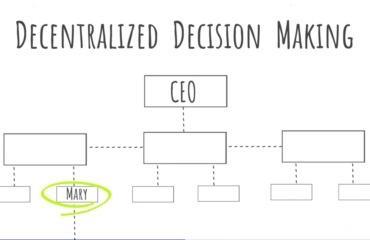As Agile practitioners, we believe in empowering employees and teams and pushing down decisions, reduces wait states, and puts the decisions in the hands of the people closest to the work. All good things! But it’s important to acknowledge that not every decision can or should be pushed down.
Decision-making to the lowest level. Agile tells us that decentralized decision-making speeds. In a recent interview with Tim Ferris, American General Stanley McChrystal posited that one of our biggest blunders during COVID was in decentralizing decision making. Rather than responding to this crisis as a globe, we responded as nations and, in America, even as local municipalities. Though the same virus was impacting us all, there was no united response strategy across the globe.
The benefits of having a decision come from a single leader (or small group of leaders) can also be significant: ideally that decision is clear, unified, and takes in a broad view of the company’s departments and interests. Being able to look at the entire company, rather than zooming in on a specific piece, allows these leaders to have (arguably) more objectivity and perspective. They also have the resources to get necessary data and resources to support the decision.
So the question we ask today is, “When should we decentralize decision-making, and when do we need a decision from ‘the top’?” Here are some considerations to guide you:
Consider the impact
- Is the impact broad or narrow? Broader impact decisions probably need more input from team leads or department heads, or need to be decided by an executive with a holistic perspective.
- Does the impact carry a lot of risk? High risk decisions (risk to reputation, profit, resources, etc.) may garner you a lot of career danger if they go awry. Good to get other leaders in the boat with you.
Consider the timing
- How quickly do we need to act? The more decision makers and gate keepers that are involved, the slower the decision will be made. Will the opportunity pass by the time you get approval? It might be a better decision to push down than up.
Consider the growth opportunity
- Is this an employee you want to grow into a more impactful leader? Then it may help them to start making more decisions on their own. Just make sure they know when to involve other leaders, and also receive feedback on how their decisions have affected the team and org. As they increase their decision making abilities, they’ll need to learn which choices they’ve made that have helped and which have hindered.
Empowering employees to make new decisions is an important part of coaching and growing your team. In her book Fierce Conversations, Susan Scott describes a “tree conversion” in which the most impactful, high-risk decisions in an org (core values, mission, core products) are the “roots” of the tree and need the most sign-off, while the trunk represents decisions that a leadership team could decide (marketing campaigns, new product features), and the branches and leaves represent even lower-risk decisions that your employee could make on their own or with little guidance. The most important part of this model is that, like a tree, this model should be growing and changing, pushing new decisions outward (from “needs sign-off” to “empowered to decide”). If your employees have to keep asking for permission on the same decisions, they’re not growing, and it’s likely that you’re missing out on growth and delegation opportunities yourself!
Note: We’ve provided some considerations to help you decide whether to decentralize, but we want to acknowledge how complex this question is! In the afore-mentioned Tim Ferris podcast, General McChrystal points out that decentralizing decision-making during COVID was a result of time pressure– we needed to respond quickly! But that’s at odds with the consideration of impact– more perspectives could have come together because our response to COVID had such a huge impact around the globe. Decentralizing OR top-down decision-making would have made sense based on the considerations we’ve outlined. There’s not always a clear “right” decision.
Take-Aways: High risk, broad impact decisions may need to be escalated, especially if there is time to spare. For the lower risk decisions, use the opportunity to train a new leader, increasing their decision-making responsibilities over time.
Questions: Do you agree? Disagree? What experiences have you had with too much/too little decision-making empowerment? When should you escalate to a higher authority?

